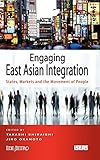Engaging East Asian Integration : States, Markets and the Movement of People / ed. by Takashi Shiraishi, Jiro Okamoto.
Material type: TextPublisher: Singapore : ISEAS Publishing, [2012]Copyright date: ©2012Description: 1 online resource (239 p.)Content type:
TextPublisher: Singapore : ISEAS Publishing, [2012]Copyright date: ©2012Description: 1 online resource (239 p.)Content type: - 9789814380287
- 9789814380294
- Australia--Foreign economic relations--East Asia--Congresses
- East Asia--Economic integration--Congresses
- East Asia--Foreign economic relations--Australia--Congresses
- East Asia--Foreign economic relations--Japan--Congresses
- Human capital -- East Asia -- Congresses
- Human capital--East Asia--Congresses
- Japan--Foreign economic relations--East Asia--Congresses
- BUSINESS & ECONOMICS / Development / Economic Development
- 337.5 23
- HF1583
- online - DeGruyter
| Item type | Current library | Call number | URL | Status | Notes | Barcode | |
|---|---|---|---|---|---|---|---|
 eBook
eBook
|
Biblioteca "Angelicum" Pont. Univ. S.Tommaso d'Aquino Nuvola online | online - DeGruyter (Browse shelf(Opens below)) | Online access | Not for loan (Accesso limitato) | Accesso per gli utenti autorizzati / Access for authorized users | (dgr)9789814380294 |
Frontmatter -- Contents -- Foreword -- List of Figures and Tables -- Contributors -- Contributors -- PART I. Evolution of East Asian Integration -- 2 Japan and East Asia in the American Imperium -- 3 Building a Neighbourhood – One Policy at a Time: The Case for Deeper Economic Integration in East Asia -- PART II. States, Markets and the Movement of People -- 4 Economic Integration in East Asia and Japan’s Strategy -- 5 The Nature of East Asian Integration and Australia’s Engagement -- 6 The Migration of Professionals in an Integrating East Asia -- 7 Panel Discussion -- Index
restricted access online access with authorization star
http://purl.org/coar/access_right/c_16ec
Both international trade and investment by East Asian countries have become significantly regionalized. To support this development further, efforts for regional integration have flourished in the forms of bilateral and regional free trade agreements and the ASEAN+3 and East Asia Summit processes, among many others. This book is a compilation of papers and discussions originally presented at the international symposium held during the recent global financial crisis. The symposium aimed to shed light not only on the usual economic aspect but also on other aspects of the multidimensional phenomenon called "regional integration". Thus, in this volume the authors explore the relationship between the U.S. influence and East Asian regionalism, the characteristics of East Asian integration, and the politics of inclusion/exclusion in the integration process. In addition, they point out some "missing links" in integration efforts such as cooperation in the areas of logistics, finance, trade in services, infrastructure and human resource movement. Since the global financial crisis did not deter integration efforts (rather, it has encouraged them), this book serves as a guide for future East Asian integration in terms of what to expect and what is to be done.
Mode of access: Internet via World Wide Web.
In English.
Description based on online resource; title from PDF title page (publisher's Web site, viewed 01. Dez 2022)


